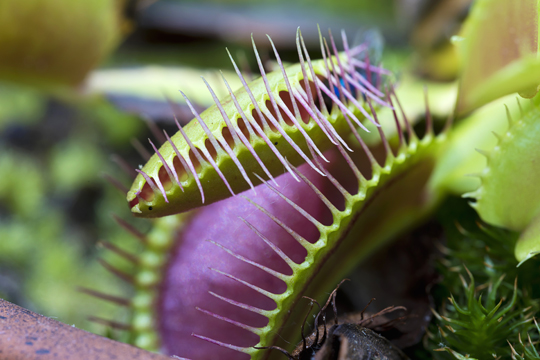The artificial trap
The botanist and biomechanic Thomas Speck recreates natural principles in a remarkably authentic way
The artificial Venus flytraps that Thomas Speck has developed should be indistinguishable in look and function. Up to now, the researcher has had to make do with the original. Photo: Jürgen Gocke
Plant-based or artificial, the Martian wonders. If it cannot tell, Thomas Speck will have achieved one of his goals at the livMatS Cluster of Excellence: “We want to pass the Turing test for materials,” said the botanist who heads the group Plant Biomechanics and Bionics at the Institute of Biology II at the University of Freiburg and is director of the Botanic Garden. Alan Turing was a British computer scientist. According to Turing, computers have artificial intelligence in which it is impossible to tell whether we are talking to machines or humans during a conversation. Together with other experts, Speck is building a complex plant trap without living materials. He hopes that his artificial Venus flytrap will soon master a modified Turing test: “It should look so real that a Martian could not distinguish originals and imitations from one another.”
The plant can taste whether its prey is suitable
The carnivorous plant leaves act as a trap. Its halves collapse in 100 milliseconds. “The movement is one of the fastest in the plant kingdom and the system is one of the most complex in nature, which does not require a central control unit,” emphasizes Speck. Sophisticated processes regulate the capture of its prey, saving the plant a lot of energy. By cutting the leaf halves apart through growth processes, the sundew plant creates an initial tension in its traps, similar to loading the feather of a mousetrap. This feat of strength costs energy. When prey falls into the trap, it closes and digestive juices flow into it. “The Venus flytrap forms an outer stomach,” says the botanist, something that once again costs energy.
Only worthwhile bites, not raindrops or dust grains, may trigger the traps. “Therefore, prey must repeatedly deflect one or more of their sensor bristles on the leaf within a few seconds.” The plant remembers the first contact and waits for others: “It has a mechanical memory.” If the arousal pattern is correct, the water pressure in some leaf cells decreases. The initial tension is released…and snap! But first, the leaf halves close incompletely. At the edge they leave narrow gaps. Small prey unworthy of digestion are able to escape. The botanist says: “The plant also tastes, so to speak, whether a prey is suitable.”
Supernatural powers
At present, the artificial traps in the laboratories are reminiscent of folded paper planes. Martians could easily distinguish real from false. However, the replicas already have supernatural abilities. The original only knows to open and close. Speck’s artificial traps, on the other hand, can open and close seamlessly. “We have coupled two biological mechanisms,” said Speck. The Venus flytrap works with initial tension and with changes in the cells’ water pressure: “On the other hand, we can control our traps magnetically, with air pressure, i.e. pneumatically, with a combination of heat and moisture, or with materials with shape memory.” He speaks of “going beyond biology,” – that is, going beyond nature. In livMatS, researchers not only want to adopt biological principles, but also to improve, expand and adapt them for new applications.

The leaves of a Venus flytrap collapse in 100 milliseconds. The movement is one of the fastest in the plant kingdom. Photo: Jürgen Gocke
Speck and his Freiburg cooperation teams from the Institute for Inorganic Chemistry at the University of Freiburg and the Fraunhofer Institute for Solar Energy Systems ISE are still at the beginning of the trap system. But it’s just one of Speck’s livMatS collaborations: “We’re mainly introducing bioinspiration.” The botanist and his group are very familiar with natural principles such as traps, functional surfaces or shock-absorbing shells. They have structurally analyzed and mechanically tested many biological and synthetic materials, valuable information for the Cluster of Excellence, which deals with “living, adaptive and energy-autonomous material systems.”
More stable without pressure
Researchers at the Institutes for Physics and Macromolecular Chemistry, the Faculty of Engineering and the Fraunhofer Institute for Mechanics of Materials IWM work with Speck on form-adaptive materials. Inspired by the shell of the pomelo fruit, they want to equip protective helmets with fiber-reinforced auxetic foams. They do not become thinner when local pressure is applied, but thicker and more stable. “They cushion shocks almost 25 percent better than polystyrene of the same thickness,” says Speck. Some products that will soon be on the market are already using this natural principle. Speck wants to develop it further with new materials.
Together with scientists from the Faculty of Engineering and the Institute for Macromolecular Chemistry, he is researching soft grippers for so-called soft robots. The experts want to “snatch up” flexible polymer systems. The interactive and adaptive materials will adapt themselves to external conditions and combine sensor and motor functions. According to the plan, soft robots will not only be able to catch balls with appropriate grippers, but will also be able to automatically and autonomously sense their properties. These include mass, hardness and surface structure. Speck expects the first prototypes in less than three years.
“These are our three demonstrators,” he sums up. They are intended to draw attention to livMatS and its research. For example, it would be welcome if industry were interested in concrete joint projects. In addition, the Cluster of Excellence wants to show what can be done with clever materials, such as the artificial Venus flytrap. “We build them because we can,” says Speck. “This is basic research with no primary application in mind. Surprisingly, however, even here a possible use in robotics is thinkable. Everything is coming together; anything seems possible. Thomas Speck still has one problem with the trap project, however: Where will he get the Martians for the Turing tests?
Jürgen Schickinger


